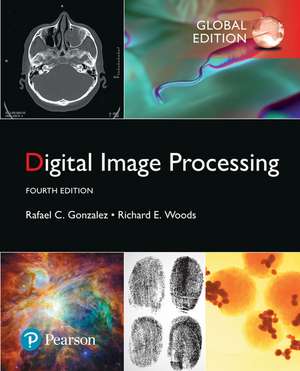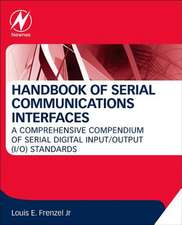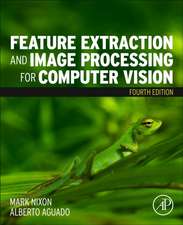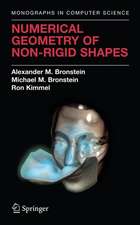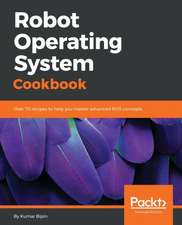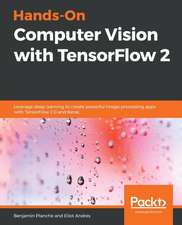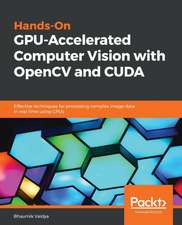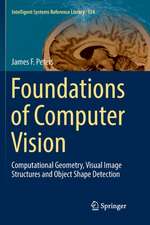Digital Image Processing, Global Edition
Autor Rafael C. Gonzalez, Richard E. Woodsen Limba Engleză Paperback – 28 apr 2018
For courses in Image Processing and Computer Vision. Introduce your students to image processing with the industry's most prized text For 40 years, Image Processing has been the foundational text for the study of digital image processing. The book is suited for students at the college senior and first-year graduate level with prior background in mathematical analysis, vectors, matrices, probability, statistics, linear systems, and computer programming.
As in all earlier editions, the focus of this edition of the book is on fundamentals. The 4th Edition, which celebrates the book's 40th anniversary, is based on an extensive survey of faculty, students, and independent readers in 150 institutions from 30 countries. Their feedback led to expanded or new coverage of topics such as deep learning and deep neural networks, including convolutional neural nets, the scale-invariant feature transform (SIFT), maximally-stable extremal regions (MSERs), graph cuts, k-means clustering and superpixels, active contours (snakes and level sets), and exact histogram matching.
Major improvements were made in reorganizing the material on image transforms into a more cohesive presentation, and in the discussion of spatial kernels and spatial filtering. Major revisions and additions were made to examples and homework exercises throughout the book. For the first time, we added MATLAB projects at the end of every chapter, and compiled support packages for students and faculty containing, solutions, image databases, and sample code.
Preț: 567.69 lei
Preț vechi: 709.62 lei
-20% Nou
108.63€ • 113.94$ • 90.43£
Carte disponibilă
Livrare economică 11-25 martie
Livrare express 25 februarie-01 martie pentru 64.07 lei
Specificații
ISBN-10: 1292223049
Pagini: 1024
Dimensiuni: 234 x 195 x 40 mm
Greutate: 1.73 kg
Ediția:4th edition
Editura: Pearson
Colecția Pearson Higher Education
Cuprins
- 1 Introduction
- 1.1 What is Digital Image Processing?
- 1.2 The Origins of Digital Image Processing
- 1.3 Examples of Fields that Use Digital Image Processing
- 1.4 Fundamental Steps in Digital Image Processing
- 1.5 Components of an Image Processing System
- 2 Digital Image Fundamentals
- 2.1 Elements of Visual Perception
- 2.2 Light and the Electromagnetic Spectrum
- 2.3 Image Sensing and Acquisition
- 2.4 Image Sampling and Quantization
- 2.5 Some Basic Relationships Between Pixels
- 2.6 Introduction to the Basic Mathematical Tools Used in Digital Image Processing
- 3 Intensity Transformations and Spatial Filtering
- 3.1 Background
- 3.2 Some Basic Intensity Transformation Functions
- 3.3 Histogram Processing
- 3.4 Fundamentals of Spatial Filtering
- 3.5 Smoothing (Lowpass) Spatial Filters
- 3.6 Sharpening (Highpass) Spatial Filters
- 3.7 Highpass, Bandreject, and Bandpass Filters from Lowpass Filters
- 3.8 Combining Spatial Enhancement Methods
- 3.9 Using Fuzzy Techniques for Intensity Transformations and Spatial Filtering
- 4 Filtering in the Frequency Domain
- 4.1 Background
- 4.2 Preliminary Concepts
- 4.3 Sampling and the Fourier Transform of Sampled Functions
- 4.4 The Discrete Fourier Transform of One Variable
- 4.5 Extensions to Functions of Two Variables
- 4.6 Some Properties of the 2-D DFT and IDFT
- 4.7 The Basics of Filtering in the Frequency Domain
- 4.8 Image Smoothing Using Lowpass Frequency Domain Filters
- 4.9 Image Sharpening Using Highpass Filters
- 4.10 Selective Filtering
- 4.11 The Fast Fourier Transform
- 5 Image Restoration and Reconstruction
- 5.1 A Model of the Image Degradation/Restoration Process
- 5.2 Noise Models
- 5.3 Restoration in the Presence of Noise Only-Spatial Filtering
- 5.4 Periodic Noise Reduction Using Frequency Domain Filtering
- 5.5 Linear, Position-Invariant Degradations
- 5.6 Estimating the Degradation Function
- 5.7 Inverse Filtering
- 5.8 Minimum Mean Square Error (Wiener) Filtering
- 5.9 Constrained Least Squares Filtering
- 5.10 Geometric Mean Filter
- 5.11 Image Reconstruction from Projections
- 6 Wavelet and Other Image Transforms
- 6.1 Preliminaries
- 6.2 Matrix-based Transforms
- 6.3 Correlation
- 6.4 Basis Functions in the Time-Frequency Plane
- 6.5 Basis Images
- 6.6 Fourier-Related Transforms
- 6.7 Walsh-Hadamard Transforms
- 6.8 Slant Transform
- 6.9 Haar Transform
- 6.10 Wavelet Transforms
- 7 Color Image Processing
- 7.1 Color Fundamentals
- 7.2 Color Models
- 7.3 Pseudocolor Image Processing
- 7.4 Basics of Full-Color Image Processing
- 7.5 Color Transformations
- 7.6 Color Image Smoothing and Sharpening
- 7.7 Using Color in Image Segmentation
- 7.8 Noise in Color Images
- 7.9 Color Image Compression
- 8 Image Compression and Watermarking
- 8.1 Fundamentals
- 8.2 Huffman Coding
- 8.3 Golomb Coding
- 8.4 Arithmetic Coding
- 8.5 LZW Coding
- 8.6 Run-length Coding
